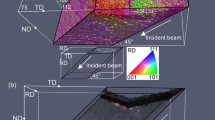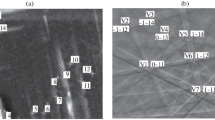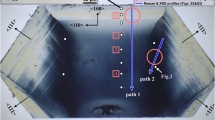Abstract
The pressure and temperature conditions of formation of natural diamond can be estimated by measuring the residual stress that an inclusion remains under within a diamond. Raman spectroscopy has been the most commonly used technique for determining this stress by utilising pressure-sensitive peak shifts in the Raman spectrum of both the inclusion and the diamond host. Here, we present a new approach to measure the residual stress using quantitative analysis of the birefringence induced in the diamond. As the analysis of stress-induced birefringence is very different from that of normal birefringence, an analytical model is developed that relates the spherical inclusion size, R i, host diamond thickness, L, and measured value of birefringence at the edge of the inclusion, \( \Updelta n(R_{\text{i}} )_{\text{av}} \), to the peak value of birefringence that has been encountered; to first order \( \Updelta n_{\text{pk}} = (3/4)(L/R_{\text{i}} ) \, \Updelta n(R_{\text{i}} )_{\text{av}} \). From this birefringence, the remnant pressure (P i) can be calculated using the photoelastic relationship \( \Updelta n_{\text{pk}} = - (3/4)n^{3} q_{\text{iso}} P_{\text{i}} \), where q iso is a piezo-optical coefficient, which can be assumed to be independent of crystallographic orientation, and n is the refractive index of the diamond. This model has been used in combination with quantitative birefringence analysis with a MetriPol system and compared to the results from both Raman point and 2D mapping analysis for a garnet inclusion in a diamond from the Udachnaya mine (Russia) and coesite inclusions in a diamond from the Finsch mine (South Africa). The birefringence model and analysis gave a remnant pressure of 0.53 ± 0.01 GPa for the garnet inclusion, from which a source pressure was calculated as 5.7 GPa at 1,175°C (temperature obtained from IR analysis of the diamond host). The Raman techniques could not be applied quantitatively to this sample to support the birefringence model; they were, however, applied to the largest coesite inclusion in the Finsch sample. The remnant pressure values obtained were 2.5 ± 0.1 GPa (birefringence), 2.5 ± 0.3 GPa (2D Raman map), and 2.5–2.6 GPa (Raman point analysis from all four inclusions). However, although the remnant pressures from the three methods were self-consistent, they led to anomalously low source pressure of 2.9 GPa at 1,150°C (temperature obtained from IR analysis) raising serious concerns about the use of the coesite-in-diamond geobarometer.




Similar content being viewed by others
References
Adams HG, Cohen LH, Rosenfeld JL (1975a) Solid inclusion piezothermometry I: comparison dilatometry. Am Mineral 60:574–583
Adams HG, Cohen LH, Rosenfeld JL (1975b) Solid inclusion piezothermometry II: Geometric basis, calibration for the association quartz-garnet, and the application to some pelitic shists. Am Mineral 60:584–598
Angel RJ, Mosenfelder JL, Shaw CSJ (2001) Anomalous compression and equation of state of coesite. Phys Earth Planet Inter 124:71–79
Appleyard CM, Viljoen KS, Dobbe R (2004) A study of eclogitic diamonds and their inclusions from the Finsch kimberlite pipe, South Africa. Lithos 77:317–332
Barron LM, Mernahg TP, Barron BJ (2008a) Using strain birefringence in diamond to estimate the remnant pressure on an inclusion. Aust J Earth Sci 55(2):159–165
Barron LM, Barron BJ, Mernagh TP, Birch WD (2008b) Ultrahigh pressure macro diamonds from Copeton (New South Wales, Australia) based on Raman spectroscopy of inclusions. Ore Geol Rev 34:76–86
Berman R (1996) The diamond–graphite equilibrium calculation: the influence of a recent determination of the Gibbs energy difference. Solid State Commun 99:35–37
Bohlen SR, Boettcher AL (1982) The quartz-coesite transformation: a precise determination and the effects of other components. J Geophys Res 87:7073–7078
Bonczar LJ, Graham EK, Wang H (1977) The pressure and temperature dependence of the elastic constants of pyrope garnets. J Geophys Res 82(17):2529–2534
Bourova E, Richet P, Petitet J-P (2006) Coesite (SiO2) as an extreme case of superheated crystal: An X-ray diffraction study up to 1776 K. Chem Geol 229:57–63
Chiang C-R (2007) Stress concentration around a spherical cavity in a cubic medium. J Strain Anal 42:155–162
Conrad P, Zha C, Mao H-K, Hemley RJ (1999) The high-pressure, single-crystal elasticity of pyrope, grossular, and andradite. Am Mineral 84:374–383
Eshelby JD (1957) The determination of the elastic field of an ellipsoidal inclusion, and the related problems. Proc R Soc Lond 241:376–396
Eshelby JD (1959) The elastic field outside of an ellipsoidal inclusion. Proc R Soc Lond 252:561–569
Fei Y (1995) Thermal expansion. In: Ahrens TJ (ed) Mineral physics & crystallography: a handbook of physical constants. American Geophysical Union, Washington, pp 29–44
Fei Y, Saxena SK, Navrotsky A (1990) Internally consistent thermodynamic data and equilibrium phase relations for compounds in the system MgO–SiO2 at high pressure and high temperature. J Geophys Res 95:6915–6928
Gillet P, Sautter V, Harris JW, Reynard B, Harte B, Kunz M (2002) Raman spectroscopic study of garnet inclusions in diamonds from the mantle transition zone. Am Mineral 87:312–317
Glazer AM, Lewis JG, Kaminsky W (1996) An automatic optical imaging system for birefringent media. Proc R Soc Lond 452:2751–2765
Graham EK, Cybriwsky ZA (1981) Garnet inclusions in diamond and the state of the upper mantle. Phys Chem Mineral 7:216–222
Grimsditch MH, Ramdas AK (1975) Brillouin scattering in diamond. Phys Rev B 11(8):3139–3148
Grimsditch MH, Anastassakis E, Cardona M (1978) Effect of uniaxial stress on the zone-center optical phonon of diamond. Phys Rev B 18(2):901–904
Harris JW, Milledge HJ, Barron THK, Munn RW (1970) Thermal expansion of garnets included in diamond. J Geophys Res 75(29):5775–5792
Hemley RJ (1987) Pressure dependence of Raman spectra of SiO2 polymorphs: α-quartz, coesite, and stishovite. In: Manghnani MH, Syono Y (eds) High-pressure research in mineral physics. Terra Scientific, Tokyo, pp 347–359
Howell D (2009) Quantifying stress and strain in diamond. Dissertation, University College London
Howell D, Nasdala L (2008) Using strain birefringence in diamond to estimate the remnant pressure on an inclusion; discussion. Aust J Earth Sci 55:1175–1178
Izraeli ES, Harris JW, Navon O (1999) Raman barometry of diamond formation. Earth Planet Sci Lett 173:351–360
Kennedy CS, Kennedy GC (1976) The equilibrium boundary between graphite and diamond. J Geophys Res 81:2467–2470
Lang AR (1967) Causes of birefringence in diamond. Nature 213:248–251
Liu LG, Mernahg TP, Jaques AL (1990) A mineralogical Raman spectroscopy study on eclogitic garnet inclusions in diamonds from argyle. Contrib Mineral Petrol 105:156–161
McSkimin HJ, Andreatch P (1972) Elastic moduli of diamond as a function of pressure and temperature. J Appl Phys 43(7):2944–2948
Meyer HOA, Boyd FR (1972) Composition and origin of crystalline inclusions in natural diamond. Geochim Cosmochim Acta 36:1255–1273
Nasdala L, Brenker FE, Glinnemann J, Hofmeister W, Gasparik T, Harris JW, Stachel T, Reese I (2003) Spectroscopic 2D-tomography: residual pressure and strain around mineral inclusions in diamonds. Eur J Mineral 15(6):931–935
Nasdala L, Hofmeister W, Harris JW, Glinnemann J (2005) Growth zoning and strain patterns inside diamond crystals as revealed by Raman maps. Am Mineral 90:745–748
Nye JF (1957) Physical properties of crystals. Oxford Science Publications, Oxford
Poindexter E (1955) Piezobirefringence in diamond. Am Mineral 40:1032–1054
Reeber RR, Wang K (1996) Thermal expansion, molar volume and specific heat of diamond from 0 to 3,000 K. J Electron Mater 25:63–67
Richardson SH, Harris JW (1997) Antiquity of peridotitic diamonds from the Siberian craton. Earth Planet Sci Lett 151:271–277
Rosenfeld JL, Chase AB (1961) Pressure and temperature of crystallization from elastic effects around solid inclusions in minerals? Am J Sci 259:519–541
Sobolev NV, Fursenko BA, Goryainov SV, Shu J, Hemley RJ, Mao H-K, Boyd FR (2000) Fossilized high pressure from the Earth’s deep interior: the coesite-in-diamond barometer. Proc Natl Acad Sci 97(22):11875–11879
Taylor WR, Canil D, Milledge HJ (1996) Kinetics of Ib to IaA nitrogen aggregation in diamond. Geochim Cosmochim Acta 60(23):4725–4733
Zaitsev AM (2001) Optical properties of diamond: a data handbook. Springer, New York
Zhang Y (1998) Mechanical and phase equilibria in inclusion-host systems. Earth Planet Sci Lett 157:209–222
Acknowledgments
DH wishes to thank EPSRC and DTC for funding of his PhD during which this research was carried out. Thanks go also to the Institute of Geology and Mineralogy at the Johannes Gutenberg-University, Mainz, for use of their 2D Raman mapping equipment. We also thank DTC for allowing use of the IR equipment and Dr. David Fisher for processing the IR data. Dr. Judith Milledge is thanked for her advice and support during this project. The editor, Prof. Hans Keppler, and an anonymous reviewer are thanked for improving the manuscript. In addition, we wish to thank Dr. Sergei Goryainov, Institute of Geology & Mineralogy, Novosibirsk, Russia, for helpful comments on our manuscript and for his assistance in resolving the discrepancy between our work and that of Sobolev et al. (2000). This is contribution 628 from the Australian Research Council National Key Centre for the Geochemical Evolution and Metallogeny of Continents (www.gemoc.mq.edu.au).
Author information
Authors and Affiliations
Corresponding author
Additional information
Communicated by H. Keppler.
An erratum to this article can be found at http://dx.doi.org/10.1007/s00410-011-0694-4
Rights and permissions
About this article
Cite this article
Howell, D., Wood, I.G., Dobson, D.P. et al. Quantifying strain birefringence halos around inclusions in diamond. Contrib Mineral Petrol 160, 705–717 (2010). https://doi.org/10.1007/s00410-010-0503-5
Received:
Accepted:
Published:
Issue Date:
DOI: https://doi.org/10.1007/s00410-010-0503-5




